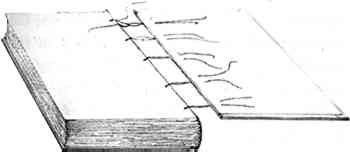RECENT TRENDS IN BOOK CONSERVATION AND LIBRARY COLLECTIONS CAREMARIA FREDERICKS
1 CONSERVATION TREATMENT OF MATERIAL IN ORIGINAL FORMATRecent trends in book conservation treatment can be characterized as much by an evolution in the conservator's approach to his or her work as by specific advances in technology or the introduction of new materials. Several factors, some of them familiar, have contributed to this development. Perhaps the most familiar and constant factor is the seemingly overwhelming quantity of deteriorating material in need of stabilization. Another constant but recently intensified condition is lack of adequate funding for preservation; growing collections must now be cared for with shrinking institutional resources. Compounding these problems is the relentless demand for the use of library materials, and use causes damage. As individual libraries have experienced cuts in acquisition funding and as cataloging information has become available on nationwide electronic networks, interlibrary loan activity has increased. Photocopying, which can literally destroy a fragile binding or a brittle book, takes place at such high volume that one conservator has described the library book of the '90s as a mere “accessory” to the production of copies (Frost 1991). While it gives the library conservator a heightened sense of purpose to be concerned with the preservation of materials people actually want to use, it is becoming more urgent than ever to devise conservation strategies that have an impact on as much of a given collection as possible, that make efficient use of financial resources, that match the treatment solution to the deterioration pattern of the item, and that target items at greatest immediate risk. This recent emphasis on productivity and cost-effectiveness does not mean that new treatment solutions are devised with less consideration for the artifact than has been traditionally employed in single-item conservation. On the contrary, the work of book conservators and preservation librarians over the last two decades has resulted in a much greater understanding of both book structure and book action on the part of both library professionals and preservation vendors. For example, librarian demand for flexible, durable, nondamaging bindings for circulating collections has led to the recent revision of the standards of the Library Binding Institute, while both in-house collections conservation units and preservation vendors have adapted conservation repair procedures to efficient, production-line work settings. At the same time, a growing desire on the part of conservators and librarians to preserve as much original material as possible has fostered an increasingly conservative treatment approach, especially for rare books. As Paul Banks pointed out in a widely quoted lecture in Austin, Texas in 1989, “authenticity cannot be restored.” Nearly every conservator I talked to prior to this session expressed a tendency to avoid extensive treatment unless a combination of frequent handling and poor condition dictates major reconstruction. Almost by happy coincidence, streamlined, less invasive conservation options have the double benefit of cost-effectiveness and the retention of more original material. Minimal structural repair and/or protective housing, often thought of as a first-phase stabilization of material slated for eventual treatment, is now quite likely to be chosen as an end in itself for rare materials receiving limited or controlled use, particularly when the authenticity of the binding structure is at stake. With this change in treatment approach comes a greater acceptance on the part of conservators and curators of a less “restored” appearance of certain objects after treatment; repairs are focused more than ever on restoring or improving aspects of function rather than appearance. One example of a recently developed repair technique that illustrates the trends described is the so-called board reattachment with joint tackets, (Espinosa 1991) in use at Brigham Young University for the repair of rare and nonrare leather-bound books whose boards are detached but are otherwise intact. (This technique is based on a repair devised by Anthony Cains, Trinity College, Dublin. [Cains and Swift 1988].) As an alternative to the potentially costly and sometimes overly invasive restoration technique known as rebacking, which involves replacement of missing areas of leather and tooling, the Brigham Young repair simply restores the function of the hinge area by lacing the boards back on using short loops, or tackets, of linen thread passed through small channels drilled into the shoulder of the text block and the spine edge of each board (fig. 1 and fig. 2). This repair can be performed in one to three hours, depending on the degree of aesthetic integration desired; the result is structurally sound and is accomplished with minimal disruption of extant original features. Similar solutions to this problem have been developed by David Brock and Don Etherington (Etherington n.d.).
|

